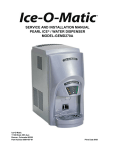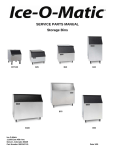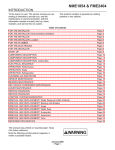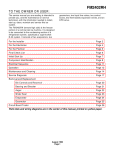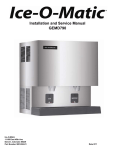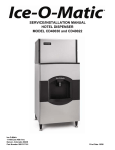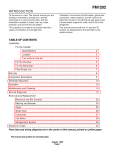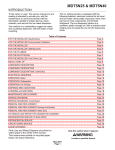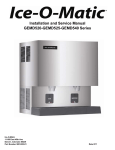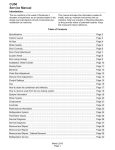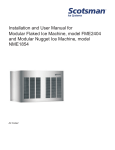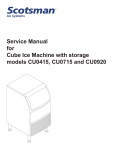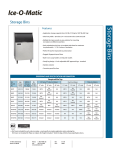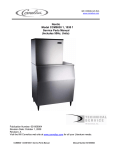Download SERVICE AND INSTALLATION MANUAL MFI 2406LS - Ice-O
Transcript
SERVICE AND INSTALLATION MANUAL MFI 2406LS Series Ice-O-Matic 11100 East 45th Ave Denver, Colorado 80239 Part Number 9081358-02 17-3168-02 Date 10/08 SERVICE PARTS MANUAL 22 INCH WIDE ICE SERIES CUBERS MODEL-ICE0320, ICE0520 Includes 50Hz. Units ICE-O-Matic 11100 East 45th Ave Denver, Colorado 80239 Part Number 9081297-01 PD04/02 Rev1/05 MFI2406LS TO THE OWNER OR USER: The service manual you are reading is intended to provide you, and the maintenance or service technician, with the information needed to install, start up, clean, maintain and service this ice system. The is the freezer portion of a commercial ice machine. It is designed to be connected to the condensing section of a refrigeration system, specifically a supermarket system. Table of Contents FOR THE INSTALLER: Specifications · · · · · · · · · · · · · · · · · · · · · · · · · · · · · · Page 2 FOR THE INSTALLER · · · · · · · · · · · · · · · · · · · · · · · · · · · · · · · · · · · · · · Page 3 FOR THE ELECTRICIAN · · · · · · · · · · · · · · · · · · · · · · · · · · · · · · · · · · · · · Page 4 FOR THE PLUMBER · · · · · · · · · · · · · · · · · · · · · · · · · · · · · · · · · · · · · · · Page 5 FOR THE INSTALLER: Final Check List · · · · · · · · · · · · · · · · · · · · · · · · · · · · · Page 6 INITIAL START UP · · · · · · · · · · · · · · · · · · · · · · · · · · · · · · · · · · · · · · · · Page 7 COMPONENT IDENTIFICATION · · · · · · · · · · · · · · · · · · · · · · · · · · · · · · · · Page 8 COMPONENT DESCRIPTION: Evaporator · · · · · · · · · · · · · · · · · · · · · · · · · · · Page 9 CONTROL BOX: Components · · · · · · · · · · · · · · · · · · · · · · · · · · · · · · · · · · Page 10 ELECTRICAL SEQUENCE · · · · · · · · · · · · · · · · · · · · · · · · · · · · · · · · · · · · Page 11 OPERATION · · · · · · · · · · · · · · · · · · · · · · · · · · · · · · · · · · · · · · · · · · · Page 12 OPERATION: Refrigeration · · · · · · · · · · · · · · · · · · · · · · · · · · · · · · · · · · · Page 13 CLEANING and SANITATION · · · · · · · · · · · · · · · · · · · · · · · · · · · · · · · · · · Page 14 SENSOR MAINTENANCE · · · · · · · · · · · · · · · · · · · · · · · · · · · · · · · · · · · · Page 15 BEARING MAINTENANCE · · · · · · · · · · · · · · · · · · · · · · · · · · · · · · · · · · · · Page 16 AUGER MAINTENANCE · · · · · · · · · · · · · · · · · · · · · · · · · · · · · · · · · · · · · Page 17 SERVICE DIAGNOSIS · · · · · · · · · · · · · · · · · · · · · · · · · · · · · · · · · · · · · · Page 18 SERVICE DIAGNOSIS · · · · · · · · · · · · · · · · · · · · · · · · · · · · · · · · · · · · · · Page 19 CONTROL SYSTEM DIAGNOSTICS · · · · · · · · · · · · · · · · · · · · · · · · · · · · · · Page 20 REMOVAL AND REPLACEMENT · · · · · · · · · · · · · · · · · · · · · · · · · · · · · · · · Page 21 REMOVAL AND REPLACEMENT: Bearing And Breaker · · · · · · · · · · · · · · · · · · · · Page 22 REMOVAL AND REPLACEMENT · · · · · · · · · · · · · · · · · · · · · · · · · · · · · · · · Page 23 REMOVAL AND REPLACEMENT · · · · · · · · · · · · · · · · · · · · · · · · · · · · · · · · Page 24 REMOVAL AND REPLACEMENT: Evaporator · · · · · · · · · · · · · · · · · · · · · · · · · · Page 25 REMOVAL AND REPLACEMENT: Gearmotor · · · · · · · · · · · · · · · · · · · · · · · · · · Page 26 WIRING DIAGRAM · · · · · · · · · · · · · · · · · · · · · · · · · · · · · · · · · · · · · · · · Page 27 This manual was printed on recycled paper, keep it for future reference. Note the Warning symbol where it appears. It marks a potential hazard. Page 1 MFI2406LS FOR THE INSTALLER: Specifications BACK VIEW 15.53" 3.1" SUCTION LINE CONNECTION 7 8" LIQUID LINE CONNECTION 12" 20.84" 9.43" 5.25" 3" 17.8" 18.8" ELECTRICAL INLET 21.66" POTABLE WATER INLET 3/8" FLARE DRAIN 3/4" FPT The machine is designed to fit a B100 Ice-O-Matic storage bin with a KBT-26. Installation Limitations: The machine is designed for indoor installations only. Minimum 50oF 40oF 198 VAC 20 psi Air Temp Water Temp Voltage Water Pressure Maximum 100oF 100oF 253 VAC 80 psi RO Water Limitation: Water conductivity must be no less than 35 microSiemens/cm. Ice-O-Matic ice machines are designed and manufactured with the highest regard for safety and performance. They meet or exceed the standards of U.L., N.S.F., and C.U.L. Ice-O-Matic assumes no liability or responsibility of any kind for products manufactured by Ice-O-Matic that have been altered in any way, including the use of any parts and/or other components not specifically approved by Ice-O-matic. Ice-O-Matic reserves the right to make design changes and/or improvements at any time. Specifications and designs are subject to change without notice. SPECIFICATIONS: Model Cabinet Size System Refrigerant BTUH required* Voltage MFI2406RL 42"w x 27"h x 24"d R-404A 12,000 208-230/60/1 Flake *Used to determine needed condensing unit capacity. Not an AC load Page 2 Ice Type MFI2406LS FOR THE INSTALLER Select the Location: The unit can only be installed indoors within the limitations described on page 2. The ice machine will have to be connected to the building’s R-404A refrigeration system, check to be sure that the system has AT LEAST enough extra capacity to handle the BTUs (from table on page 2) per hour @ 1100F. liquid line temperature (assume a 00F. evaporator temperature). Refrigeration Installation: The skills of a refrigeration technician are required to connect the ice machine to the building’s refrigeration system. Notes: · Suction Line and Liquid Line Stubs are at the back of the cabinet. · R-404A models: 1.5 ounces of R-404A refrigerant is in the system as a holding charge. · Be sure there is enough BTU capacity. · Be sure the liquid connection is NOT in series Storage Bin: Ice-O-Matic’s B100 will be the presumed bin of choice. Install the legs and place the bin into position. A KBT26 bin adapter kit is required, follow installation instructions included in the kit. with another liquid line valve. · Local Codes must be observed. · A P-trap should be installed where there will be more than 10’ of vertical rise in the suction line. The ice machine is heavy, so the use of a mechanical lift is recommended for lifting the machine high enough to install on top of the bin. Level the assembly by turning the leg levelers in or out. Locate the Nameplate: The nameplate is located on the back panel of the machine, and contains the electrical characteristics particular to the unit being installed. Page 3 MFI2406LS FOR THE ELECTRICIAN CONFORM TO ALL APPLICABLE CODES Electrical Connections: Locate the nameplate for the current requirements, and then determine the wire size and type per the National Electric Code. The machine requires a solid chassis to earth ground wire. Refer to the wiring diagram. The ice machine should be connected to it’s own electrical circuit, and be individually fused. Voltage, when the unit is under full load, must remain within the limitations listed on page 2. LOW VOLTAGE CAN CAUSE EQUIPMENT MALFUNCTION AND/OR DAMAGE All external wiring should conform to the National, State, and local electrical codes. Usually the services of a licensed electrician will be required. DETAIL OF JUNCTION BOX JUNCTION BOX POWER SUPPLY Page 4 MFI2406LS FOR THE PLUMBER CONFORM TO ALL APPLICABLE CODES Water Supply: The recommended water supply line is 3/8" O.D. copper tubing, with a minimum operation pressure of 20 PSIG, and a maximum of 80 PSIG. Connect to cold water using the male flare connection at the back of the machine. Install a shut off valve in an accessible space between the ice maker and the water supply. Drain System: All drains are of the gravity type, and must have a minimum of 1/4" fall per foot of horizontal run. The drains must be installed to conform to local plumbing codes. The use of a vent at the machine and at the bin will allow the system to drain properly. Use only rigid tubing for drains; insulation of the bin drain is recommended. 3/8" MALE FLARE 3/4" FPT SHUT OFF VALVE VENT THIS DRAIN FIELD SUPPLIED WATER FILTER WATER INLET BIN DRAIN FLOOR DRAIN Page 5 MFI2406LS FOR THE INSTALLER: Final Check List 1. Is the unit installed where the air and water temperatures are within and will remain within the limitations for the unit? 2. Is there 6" clearance at the rear of the machine for utility connections? 3. Has the water supply line be checked for pressures between 20 and 80? 4. Has the unit been leveled? 5. Has the shipping material been removed from inside the cabinet? 6. Have the electrical connections been made? 7. Have the drains been installed and checked for leaks? 8. Has the refrigeration supply been installed and checked for leaks? 9. Has the bin and cabinet been wiped clean or sanitized? 10. Has the warranty registration card been properly filled out and mailed to Ice-O-Matic? 11. Has the owner been given the service manual and been instructed on how to maintain the ice maker? 13. Has the owner been given the name and telephone number of the local Ice-O-Matic service agency? Page 6 MFI2406LS INITIAL START UP 1. Remove the top and front panels. 7. Switch on the other master (mode) switch, observe that: 3. Switch on the electrical power. · The liquid line valve opens · The gearmotor runs · Within a short time, that side of the machine 4. Open the hand valves (in the liquid lines). · Water flows from the water reservoir, and the 2. Open the water valve, and observe that the two float reservoirs fill up with water and shut off. begins to make ice. float drops, letting in more water. 5. Open the ball valves (in the suction lines). 6. Switch on one master (mode) switch, and observe: · That liquid line valve opens · The gearmotor runs · Within a short time, that side of the machine begins to make ice. · Water flows from the water reservoir, and the 8. With both sides operating, the sight glass should remain full, and the low side pressure will be about 36 PSIG, + or - 2 Gearmotor amp draw should not exceed the nameplate rating. 9. Check the system very carefully for any refrigerant leaks, repair as needed. float drops, letting in more water. Page 7 MFI2406LS COMPONENT IDENTIFICATION Liquid line valve(s) These valves operate to turn the ice making process on and off. When the ice level drops in the ice chute, the ice level sensor will cause the circuit board to close the liquid line relay, which energizes the liquid line valve for that side of the system. The liquid line valve opens, and liquid refrigerant flows to the thermostatic expansion valve. Thermostatic Expansion Valve The metering device of each system, the valve(s) sense the temperature of the suction line and vary the amount of liquid refrigerant that passes through the valve into the evaporator, thus maintaining a constant level of refrigeration. TXV’s are factory set. Do not adjust unnecessarily. DO NOT ADJUST THE TXV UNTIL THE EPR HAS BEEN SET. The superheat setting is 4-80F. Measure the temperature of the evaporator outlet at the TXV bulb, and check the low side pressure at the EPR valve. Convert the pressure to temperature (using a temperature pressure chart) and subtract the amount from the outlet temperature. The result is the superheat. Use an electronic thermometer. EPR: Evaporator Pressure Regulator Valve This valve maintains a constant pressure on its inlet (evaporators) side regardless of the pressure on the outlet (suction) side. The EPR is factory set, adjust only if needed. After adjusting, re-check TXV superheat. EPR Settings: · R-404A models: 36 PSIG Evaporators: Where the water is frozen into ice crystals. As the water cools, it begins to turn into ice, and the slowly turning auger lifts the ice, as it is being made, and forces it up and out of the “breaker” or spout where the extra water is compressed out of the ice. The ice then drops through the chute, into the storage bin. EPR VALVE THERMO VALVE LIQUID LINE VALVE THERMO VALVE EVAPORATOR Page 8 MFI2406LS COMPONENT DESCRIPTION: Evaporator Evaporator: A refrigerated vertical tube filled water and containing a water seal and auger. Auger: A solid stainless steel double spiral auger, it pushes the ice crystals up to the top of the evaporator. Water Seal: A two part “face” seal, the top half rotating with the auger, the bottom half stationary, the sealing action being where the two seal “faces” meet. Ice Sweep: A plastic cap with “fingers”. It revolves with the auger to “sweep” the ice into the ice chute. Divider: Where the ice is compressed and much of the extra water is squeezed out of it before it is discharged into the bin. Motor: A split phase motor that drives the gear reducer. Bearing: As the ice is pushed up the evaporator, the auger is thrust down, and pressure from the auger thrust is taken up by this bearing. ICE SWEEP BEARING DIVIDER EVAPORATOR AUGER WATER SEAL MOTOR Page 9 MFI2406LS CONTROL BOX: Components Circuit Board: Controlling the ice machine using input from ice and water sensors. The board switches loads on and off through relays. The relays are for the gear motor (with a built in time delay to clear the evaporator of ice when the unit turns off) and for the liquid line valve. See photo below. On/Off (Mode) Switch: Manual control for that side of the machine. Control Board Water OK Light Power Light Service Light Freeze Light Bin Full Light LED1 Compressor Relay LED3 Auger Relay Page 10 MFI2406LS ELECTRICAL SEQUENCE There are 7 indicator lights on the control board: Shut Down: · WTR-OK (Water OK). Green. Normal = Glowing. Glows when there is water in the reservoir. · PWR-OK (Power OK). Green. Normal = Glowing. Glows when the control board has power and is functional. · The compressor relay opens, LED1 goes out. · The liquid line valve closes. · The refrigerant flow stops. · The auger motor stays on for 1 more minute, clearing out ice in the evaporator, and then · The auger motor relay opens, LED3 goes out · Service. Red. Normally Off. · Freeze. Red. Normally glowing when making ice. · Bin Full. Red. Normally Off when making ice. · LED1. White. Located next to the board’s Compressor Relay (used to power the liquid line valve). Normally Glowing when making ice. · LED3. White. Located next to the board’s Auger Motor Relay. Normally Glowing when making ice. If the machine is switched off at the mode switch, but is otherwise ready to go, switching the mode switch to ON does the following: and the auger motor stops. The liquid line valve will not re-open until 2 minutes or more have passed after the last shut down. If the path between the ice level sensors remains clear for more than 10 seconds the ice machine will restart. Control Board Protection Devices · When the water level in the reservoir falls below the water level sensor’s tip, the WTR-OK light goes out and the machine shuts down. When water refills the reservoir the WTR-OK light glows and the machine starts up again. · If the auger drive motor current becomes · The PWR-OK light glows. · If there is water in the reservoir the WTR-OK light glows. · After 10 seconds the Freeze, LED1 and LED3 lights glow and the machine starts up. Start Up: · The compressor relay and auger motor relay become energized, connecting power to the windings of the auger motor and liquid line valve coil. · The liquid line valve opens, refrigerant flows to the expansion valve and ice making begins. · As ice is made it passes between the ice level sensors but because it is not a continuous stream it only interrupts the sensor’s infrared beam momentarily. The bin full light remains off and the machine stays on until ice builds up in the bin and blocks the path between the sensors for 6 seconds or longer. When that occurs the bin full light glows and the machine shuts down. excessive the compressor and auger drive motor will be switched Off and the Service light will blink. The control board will restart the auger drive motor in 4 minutes. If during the first 60 seconds after restart the auger motor current stays within limits, the liquid line valve is reopened and the machine returns to normal operation. If the auger motor’s current is excessive within 60 seconds after the restart, the process will be repeated once more. If during that try the current is still excessive the machine shuts down and must be manually reset. The service light will then be glowing continuously. To Reset: Disconnect and reconnect electrical power to the unit. The mode (on - off) switch is the manual control for the complete machine, but it is not a service disconnect. Page 11 MFI2406LS OPERATION Water Water enters the machine through the 3/8" male flare at the rear of the cabinet, goes to the water reservoir which it enters through the float valve. The water then goes out the bottom of the reservoir tank to the bottom of the evaporator. Reservoir overflow or evaporator condensation is routed to the drain. WATER INLET RESERVOIR ICE CHUTE WATER LEVEL EVAPORATOR WATER INLET WATER SCHEMATIC DRIP PAN DRAIN Page 12 MFI2406LS OPERATION: Refrigeration The remote high side supplies high pressure liquid refrigerant to the liquid line connection on the ice machine. After the sight glass, there are two separate liquid lines, each leading to a liquid line valve. When the individual ice level sensor causes the circuit board to energize the liquid line valve, the valve opens, allowing the liquid refrigerant to enter that expansion valve. The thermostatic expansion valve meters the liquid refrigerant into the evaporator, where it boils off (evaporates) and absorbs heat. It then moves through the ball valve and into the evaporator pressure regulator valve, or EPR. The EPR keeps the evaporator pressure above a predetermined point, even though the suction line pressure of the remote high side HAND VALVE system may vary. The refrigerant, now a low LIQUID LINE pressure gas, moves into VALVE the suction line of the remote high side system. LIQUID LINE SIGHT GLASS THERMO VALVE EVAPORATORS BALL VALVES SUCTION LINE EPR VALVE Page 13 MFI2406LS CLEANING and SANITATION An Ice-O-Matic ice system represents a sizable investment of time and money in any company’s business. In order to receive the best return for that investment, it MUST receive periodic maintenance. It is the USER’S RESPONSIBILITY to see that the unit is properly maintained. It is always preferable, and less costly in the long run, to avoid possible down time by keeping it clean; adjusting it as needed; and by replacing worn parts before they can cause failure. The following is a list of recommended maintenance that will help keep the machine running with a minimum of problems. Maintenance and Cleaning should be scheduled at a minimum of twice per year. ICEMAKING SYSTEM: In place cleaning 1. Check and clean any water treatment devices, if any are installed. 2. Pull out and remove the front panel. 3. Move the ON-OFF switch to OFF. 4. Remove all the ice from the storage bin. 5. Remove the cover to the water reservoir and block the float up. 6. Drain the water reservoir and freezer assembly using the drain tube attached to the freezer water inlet. Return the drain tube to its normal upright position and replace the end cap. 7. Prepare the cleaning solution: Mix eight ounces of ice machine cleaner with three quarts of hot water. The water should be between 90-115 degrees F. Ice Machine Cleaner contains acids. These compounds may cause burns. If swallowed, DO NOT induce vomiting. Give large amounts of water or milk. Call Physician immediately. In case of external contact, flush with water. Keep out of the reach of children. 8. Slowly pour the cleaning solution into the water reservoir until it is full. Wait 15 minutes, then switch the master switch to ON. 9. As the ice maker begins to use water from the reservoir, continue to add more cleaning solution to maintain a full reservoir. 10. After all of the cleaning solution has been added to the reservoir, and the reservoir is nearly empty, switch the master switch to OFF. 11. After draining the reservoir, as in step 6, wash and rinse the water reservoir. 12. Go thru steps 13-19 to sanitize the ice machine water system. 13. Mix two gallons of sanitizer solution. Use an approved sanitizer. A possible sanitizer solution may be obtained by mixing two gallons of warm (90-115oF.) potable water with 1 ounce of household bleach. 14. Slowly pout the sanitizer solution into the water reservoir until the float rises, then switch the master switch ON. 15. As the ice machine uses water from the reservoir, continue to pour the sanitizer solution into the reservoir. 16. After 12 of the sanitizer solution has been added to the reservoir, and the reservoir is nearly empty, switch the master switch OFF. 17. Drain the reservoir and thoroughly wash the interior of the reservoir and cover with sanitizer solution. Be sure the drain hose is upright and capped. 18. Remove the block from the float in the water reservoir. 19. Switch the master switch to ON 20. Continue ice making for at least 15 minutes, to flush out any cleaning solution. DO NOT USE any ice produced from the cleaning solution. Be sure no ice remains in the bin. 21. Remove all ice from the storage bin. 22. Add warm water to the ice storage bin and thoroughly wash and rinse all surfaces within the bin. 23. Sanitize the bin interior by washing the interior of the bin with the balance of the sanitizer solution. 24. Switch the master switch ON. Page 14 MFI2406LS SENSOR MAINTENANCE 1. The bin control uses devices that sense light, therefore they must be kept clean enough so that they can “see”. At least twice a year, remove the bin control sensors from the base of the ice chute, and wipe the inside clean, as illustrated. 2. The ice machine senses water level by a probe located in the water reservoir. At least twice a year, the probe should be removed from the reservoir, and the tip wiped clean of mineral build-up. SLIDE ICE LEVEL CONTROLS OUT OF CHUTE CLEAN THE ICE LEVEL CONTROL SENSORS Clean the Probe's Tip with ice machine cleaner and a clean, soft cloth. Page 15 MFI2406LS BEARING MAINTENANCE · unscrewing the auger stud The top bearing in the breaker should also be checked at least two times per year. Check the breaker bearing by: Auger Stud · removing the ice chute cover Chute Cover Cap Screw · unscrewing the ice sweep Ice Sweep Inspect the bearing. There should be plenty of grease in sight. If grease is needed the bearing and breaker should be removed to check the action of the bearing. It should rotate smoothly. To remove the breaker take out all four allen head cap screws and pull the breaker off the auger and evaporator. If the bearing only needs grease, inject grease into the bearingusing a grease needle. Be sure to inject grease evenly and thoroughly. See Removal and Replacement section to replace bearing or seals. Reverse to reassemble. Grease Needle · removing the water shed and the breaker cover (left hand thread) Breaker Cover Off Page 16 MFI2406LS AUGER MAINTENANCE In some installations the water supply to the ice maker will be so concentrated with dissolved minerals, (such as calcium carbonate) that as ice is made, the evaporator and auger become coated with those minerals, requiring a more frequent cleaning than twice per year. If in doubt about the condition of the evaporator and auger, the auger can be removed so the parts can be inspected. Note: Water filters can filter out suspended solids, but not dissolved solids. “Soft” water may not be the complete answer. Check with a water treatment specialist regarding water treatment. Note: Flaker Components Shown, Nugget Components are Similar DIVIDER, AUGER AND SLOTTED COLLAR ALLEN HEAD SCREWS Switch off electrical power, and shut off the water supply. For more information on removal of these parts, see REMOVAL AND REPLACEMENT. 1. To remove the auger, remove front and top panel. See Removal And Replacement. 2. Push bail clamp back and remove ice chute cover. 3. Unscrew and remove ice sweep. 4. Remove ice chute from evaporator. 5. Remove 4 allen head screws holding breaker to evaporator. 6. Pull up on breaker to remove auger. Allow the auger to dry, the stainless steel of the auger and evaporator must be clean and bright. Clean the auger and evaporator as required. DO NOT HONE THE EVAPORATOR. 7. Replace the water seal. 8. Reverse to reassemble. BREAKER COVER Page 17 MFI2406LS SERVICE DIAGNOSIS Symptom No ice is made, nothing operates Possible Cause Unit off due to no power. Unit off due to master switch in Off position Unit off due to low water level in reservoir Unit off due to ice level sensors (photo-electric eyes) blocked Unit off due to scale on water level sensor Auger motor hums but does not turn No ice, auger motor is turning Unit makes ice, but very slowly Probable Correction Restore power Move master switch to ON Check water supply, filter and float valve. Check/clean ice level sensors Clean water level sensor Auger can’t turn. Circuit board has not yet shut unit down. Auger turning but there is no refrigeration Liquid line valve not opening, effect check coil, check board relay. No refrigerant to ice machine, check main system. Unit is shut down Circuit board has shut ice machine down due to high auger motor amp draw. Check for cause of high amp draw, including bearings, gear motor condition and scale on auger & evaporator. May also be due to liquid line valve leak thru during the off cycle. Check valve. Auger not turning Due to: motor failure; auger relay failure on circuit board; or gears stripped. Check drive train. Low suction pressure Liquid line valve not opening due to coil failure or failure of compressor relay on circuit board EPR setting too low, check/adjust TXV restricted or not metering. Check bulb temperature. No power to circuit board Check harness Circuit board gear motor relay will not close Check / replace board Water level or ice level sensor failed Check / replace sensor Liquid line valve coil is open Check / replace valve coil Circuit board relay will not close Check / replace board High discharge pressure because of dirty Clean condenser. condenser Auger and evaporator are coated with Clean the water system minerals Low suction pressure due to low EPR Adjust EPR, check TXV setting superheat Page 18 MFI2406LS SERVICE DIAGNOSIS Symptom Possible Cause Probable Correction Water Leak Drain plugged up Clean out drain Tubing cracked Replace tubing Condensation on drain tubing Insulate tubing Hose off Reattach hose Reservoir cover off Return cover to reservoir Reservoir cracked Replace reservoir Evaporator water seal leaks Check base of evaporator & drip pan. If the seal leaks, shut off the water, remove the auger, replace the water seal. Check gear motor for water infiltration. Uses too much water Reservoir float valve leaks thru Replace float valve or seat Excessive ice meltage Bin drain clogged Clean out bin drain. Improper installation of drains, they are connected. Drains must be separate. Poor fit between bin door and door frame Adjust or replace Evaporator coated internally with minerals Clean with Ice Machine Cleaner Motor bearings dry Oil or replace motor Machine makes too much noise Page 19 MFI2406LS CONTROL SYSTEM DIAGNOSTICS The control system consists of: · Control Board · Water Sensor · Ice Sensors If the unit is OFF, check the control board: 1. Is the Power OK light on? If not check power to the unit. If it has power, and the Power OK light is NOT on, check the high pressure and low pressure cut outs. If they are both closed, replace the board. If the Power OK light is ON, go to the next step. 2. Is the Water OK light on? If it is, go to the next step. If not, check the water level in the reservoir. If there is water in the reservoir, check that the water sensor is plugged in. To check the water sensor: A. Unplug water sensor. B. Pull water sensor from reservoir. C. Place one ohmmeter lead on the sensor's plug and the other on the sensor's tip. The meter should show nearly zero resistance. If it reads infinite resistance, check the tip for corrosion. If it is clean and still reads open, replace the sensor. OR connect a copper wire to the wire where the water sensor plugs into and place the other end in the water. The water OK light should go ON. If it does not, replace the control board. 3. Ice sensor check. Is the Bin Full light Off? If it is OFF and the Service light is Off, and the unit is not running, replace the control board. If it is OFF and the auger motor is running but the compressor is not, check the compressor contactor coil. If it is on, the ice sensors may be blocked. Remove them and check for mineral scale. Scotsman's test box can also be used to determine if the ice sensors or board are defective. Using the tester: A. Disconnect the ice sensors at the connection by the ice chute. Connect the LED and PHOTO TRANS wires to the control board's wires. B. With the On - Off (mode) switch in either position, move the Bin Full switch on the tester to Bin Full the tester's light will blink and after a few seconds the bin full light on the control board will come on. If not, replace the board. Move the Bin switch on the tester to Bin Empty. The light on the tester will go out, and after a few seconds the Bin Full light on the board will go out. If master switch is ON, the unit should start. Page 20 MFI2406LS REMOVAL AND REPLACEMENT WATER RESERVOIR 1. Shut off the water supply to the ice maker. 2. Remove front panel and reservoir cover. 3. To remove float only, disconnect water inlet tube, push in the tab behind the reservoir and pull valve assembly out of the reservoir tank. 4. To remove reservoir, disconnect water inlet compression fitting at reservoir inlet. 5. Remove drain hose from reservoir. 6. Remove evaporator inlet hose from reservoir. 7. Remove mounting screws from reservoir bracket, and remove reservoir from ice maker. 8. Reverse to reassemble. BIN CONTROLS (Ice Level Sensors) 1. Disconnect electrical power. 2. Remove front panel. 3. Remove control box cover. 4. Locate ice chute, at the base of the chute, in front of and behind it are two plastic bin control mounts. 5. Slide each bin control to the left, and in the control box, disconnect the electrical leads connecting the bin control to the circuit board. 6. Reverse to reassemble, be certain that the bin controls are aligned so that the ice level sensors are visible (centered) through the holes in the cube chute. SLIDE BIN CONTROLS IN AND OUT Page 21 MFI2406LS REMOVAL AND REPLACEMENT: Bearing And Breaker Note: Removal of the auger, water seal, evaporator and gearmotor must begin at the top of the assembly. To Remove the Breaker Bearing Assembly: Electrical Shock Hazard Electrical shock can cause personal injury. Disconnect electrical power before beginning. 1. Remove panels and disconnect electrical power. 2. Push back bail clamp, remove insulation retaining strap and insulation, remove ice chute cover. 3. Unscrew and remove ice sweep. 4. Lift up and remove ice chute. 5. The breaker may be removed from the auger and evaporator without disturbing the auger. a. Unscrew breaker cover from breaker (left hand threads) b. Unscrew auger stud from top of auger. c. Unscrew 4 allen head cap screws holding breaker to evaporator. Step 5- a d. Lift up, and remove breaker/bearing assembly from auger & evaporator. 6. Service the bearing. Check for rust, rough spots and damage. a. The bearing is pressed into the breaker, to remove the bearing and replace it an arbor press is needed. b. Replace lower seals before installing new bearing in breaker. Note: seals must be pressed in with a tool pushing against the outer edge only, they will not install by hand. Replace parts as required. Re-grease bearing with Ice-O-Matic part no. 6051062-01 bearing grease. Replace top seal, and check the o-rings, replace if cut or torn. 7. Reverse to reassemble: specific tools and materials are required to install properly. a. Add food grade grease such as Ice-O-Matic part number 6051036-01 to the seal area before installing on the auger. b. Check the seal to shaft areas for cuts, or rough spots: none are permitted. Step 5-b Step 5-c and Step 6 BEARING ICE SWEEP SEALS SLOTTED COLLAR AUGER STUD BREAKER COVER DIVIDER Page 22 MFI2406LS REMOVAL AND REPLACEMENT To Remove the Auger: Turn off the water to the machine, and unclip the evaporator drain hose, pull it down and drain the evaporator into the bin or a container. Moving Parts Hazard Moving parts can cause personal injury. Disconnect electrical power before beginning. 1. The top panel must be removed. 2. Remove ice chute cover. 3. Unscrew ice sweep. 4. Remove ice chute body. 5. The auger and breaker/bearing may now be removed as an assembly. a. Unscrew 4 allen head cap screws holding breaker to evaporator. b. Lift up on breaker and remove auger from evaporator. e. If the auger is stuck use a slide hammer type puller to pull on the auger at the threaded hole. The size of that hole is 5/8"-18. Inspect the auger, the critical areas of the auger are: 1. The auger body. It should be clean and shining. Sometimes an auger will appear clean when wet, but after it is dry it will be seen to be stained. Scrub the auger with ice machine cleaner and hot water. Ice machine cleaner is an acid. Handle it with extreme care, keep out of the reach of children. 2. The water seal area. Because the auger has been removed, the water seal will have to be replaced. Remove the water seal top half from the auger, and inspect the auger for minerals clean as required. SLIDE HAMMER PULLER DIVIDER AND AUGER ASSEMBLY Note: If the auger is stuck, the breaker must be removed from the auger. The breaker may be removed from the auger and evaporator without disturbing the auger. a. Use spanner wrench and unscrew breaker cover from breaker (left hand threads) b. Unscrew auger stud from top of auger. c. Unscrew 4 allen head cap screws holding breaker to evaporator. d. Lift up and remove breaker from evaporator. Page 23 MFI2406LS REMOVAL AND REPLACEMENT Moving Parts Hazard. Moving parts can cause personal injury. Disconnect electrical power before beginning. To Remove the Water Seal: (Assuming all steps to remove the auger have been performed.) 1. The gearmotor/evaporator assembly will have to be exposed. 2. Remove the 4 hex head cap screws holding the evaporator to the gearmotor assembly. Lift the evaporator up and off of the gearmotor. 3. Remove the snap ring or wire retainer from the grove under the water seal. 4. Pull or drive out the lower half of the water seal. To Replace the Water Seal: 1. Lubricate the water seal with water, and push the water seal into the bottom of the evaporator slightly past the grove for the snap ring. 2. Replace the snap ring and pull the water seal down against it. 3. The part of the water seal that rotates with the auger must also be replaced. Remove the old part from the auger and clean the mounting area. 4. Place a small bead of food grade silastic sealant (such as 732 RTV ) on the area of the auger where the water seal is to be mounted. 5. Carefully push the water seal (rubber side against the auger shoulder and the silastic.) CAUTION Do not get any silastic onto the face of the seal. 6. Allow the auger and seal to air dry until the silastic is dry on the surface. 7. If the original water seal was leaking, it would be a good idea to inspect the interior of the gearmotor. WATER SEAL RETAINING RING PLACE FOOD GRADE SEALANT HERE Page 24 MFI2406LS REMOVAL AND REPLACEMENT: Evaporator To Replace the Evaporator: (Assuming all the steps for removal of the thrust bearing, breaker, auger, and water seal have been performed.) 1. Shut the hand valves in the liquid and suction lines to the evaporator being serviced; then discharge the refrigerant. 2. Unsweat the refrigerant connections: a) At the thermostatic expansion valve outlet. CAUTION To Reassemble the Evaporator and Auger 1. After the gearmotor has been inspected, fasten the evaporator to the gear motor, torque the bolts to 110 inch pounds. 2. Lower the auger into the evaporator barrel, slightly turning it to match up with the drive end. Do Not Drop Into the Evaporator. 3. Complete the reassembly by reversing the disassembly for the breaker & thrust bearing assembly. Heat sink the TXV body when unsweating or resweating the adjacent tubing. b) At the suction line at the joint about 3" from the evaporator. 3. Remove the evaporator. 4. Unsweat the drier from the liquid line. 5. After installing a new water seal in the new evaporator (see “To Replace the Water Seal”) sweat in the new evaporator at the old connections. 6. Install an new drier in the liquid line. 7. Evacuate the system until dehydrated, then weigh in the nameplate charge. Check for leaks. 8. Install auger, breaker, breaker bearing assembly, and ice discharge chute in reverse order of disassembly. See “To Reassemble Evaporator and Auger” ICE SWEEP AUGER EVAP BEARING DR DIVIDER/BREAKER Page 25 MFI2406LS REMOVAL AND REPLACEMENT: Gearmotor To Remove and Repair the Gearmotor Assembly: (Assuming that the procedures through removal of the water seal have been performed.) 1. Remove the electrical wires from the gear drive motor. 2. Unscrew the 4 cap screws holding the gearmotor to the gearmotor plate. 3. Remove the gearmotor from the ice maker. To Inspect the gearmotor. A) Remove the cap screws holding the gearmotor case halves together and pry the two cases apart. B) To lift off the cover, lift up until you can feel internal contact, then pull the cover towards the output gear end, and then lift the cover (with drive motor attached) up and away from the gear motor case. Note: The case cover output gear, bearings, and shaft are one pressed together assembly. Replace as a unit. C) Inspect the oil, gears, GEARCASE and bearings. If the oil COVER level and condition is acceptable, quickly check the gears and bearings. They are likely to be fine if the oil is. If there is evidence of water in the oil (rusty bearings and gears; the oil having a creamy white appearance; oil level too high) carefully inspect the bearings and gears. If in doubt about the condition of a part, replace it. The oil quantity is 14 fluid ounces, do not overfill. Note: The gears and bearings are available only as pressed together sets. D) After replacing parts as required, (if any) reassemble the gearcase. The two smaller gears and the oil should be in the lower case, the output gear will be with the cover. As you lower the cover onto the lower case, cover will have to be moved closer to the second gear after the output gear has cleared the second gear top bearing. E) After the case is together, and the locating pins are secure in both ends, replace all cap screws. 4. Bench test the gearmotor, check for oil leaks, noise, and amp draw. MOTOR SEAL Page 26 BEARING GASKET MFI Series 2406LS Wiring Diagram Page 27 MFI Series Service History Service History Model Number__________________Serial Number__________________Date Installed__________ __________________________________________________________________________________________ __________________________________________________________________________________________ __________________________________________________________________________________________ __________________________________________________________________________________________ __________________________________________________________________________________________ __________________________________________________________________________________________ __________________________________________________________________________________________ __________________________________________________________________________________________ __________________________________________________________________________________________ __________________________________________________________________________________________ __________________________________________________________________________________________ __________________________________________________________________________________________ __________________________________________________________________________________________ __________________________________________________________________________________________ __________________________________________________________________________________________ __________________________________________________________________________________________ __________________________________________________________________________________________ __________________________________________________________________________________________ __________________________________________________________________________________________ __________________________________________________________________________________________ __________________________________________________________________________________________ __________________________________________________________________________________________ __________________________________________________________________________________________ __________________________________________________________________________________________ __________________________________________________________________________________________ __________________________________________________________________________________________ __________________________________________________________________________________________ __________________________________________________________________________________________ __________________________________________________________________________________________ __________________________________________________________________________________________ __________________________________________________________________________________________ __________________________________________________________________________________________ __________________________________________________________________________________________ __________________________________________________________________________________________ __________________________________________________________________________________________ __________________________________________________________________________________________ __________________________________________________________________________________________ __________________________________________________________________________________________ __________________________________________________________________________________________ __________________________________________________________________________________________ __________________________________________________________________________________________ __________________________________________________________________________________________ __________________________________________________________________________________________ __________________________________________________________________________________________ __________________________________________________________________________________________ __________________________________________________________________________________________ __________________________________________________________________________________________ __________________________________________________________________________________________ __________________________________________________________________________________________ __________________________________________________________________________________________ __________________________________________________________________________________________ __________________________________________________________________________________________ Page 28































